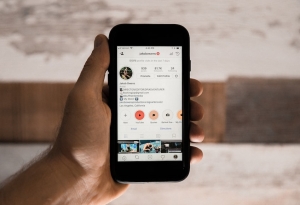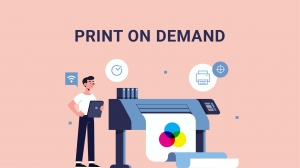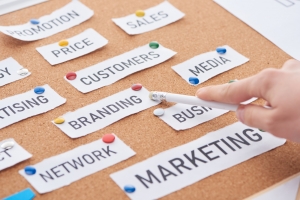It’s a frustrating feeling. You’ve built a great business, but the right customers just can’t seem to find you online. You feel like you're lost in a sea of competitors who are getting all the attention.
The truth is, visibility isn't about one magic trick. It's about building a smart, interconnected system that helps people discover you, trust you, and keep coming back for more.
Here are nine practical ways to build that system, piece by piece.
Build Your Digital Foundation (Owned Media)
This is your starting point—the digital assets you create and completely control. Before you pay for ads or ask for reviews, your own digital "home base" must be in order.
1. Optimize Your Website
Your website is the central hub for all your marketing, acting as your 24/7 salesperson and information center. If it’s slow, confusing, or broken on a phone, potential customers will leave and never come back.
Research shows that 75% of people judge a company's credibility based on its web design. A bad first impression is hard to fix. This user behavior also directly impacts your search rankings. When Google sees visitors leave your site immediately (a "high bounce rate"), it assumes your site isn't helpful and ranks you lower.
You don't need a total overhaul, just focus on the fundamentals.
a. Mobile-First Design
With over half of all global internet traffic coming from phones, your website must work flawlessly on a small screen. A site that is difficult to navigate on a phone alienates a majority of your potential customers.
b. Fast Loading Times
Modern users expect speed. Studies show that a significant percentage of visitors will abandon a page if it takes longer than three seconds to load. Simple actions, such as compressing image files to make them smaller, can dramatically improve loading speed and reduce user frustration. Getting this foundation right is critical, and if you're not sure where to start, our team at FruityLOGIC Digital Marketing Agency can help audit your site's performance and technical health.
c. Simple Navigation
Don't make people hunt for information. Your menu and layout should be clear, logical, and intuitive. Visitors should be able to find what they need without guesswork, ensuring they can achieve their goals efficiently on your site.
2. Create Genuinely Helpful Content
Stop trying to "keyword stuff" or trick algorithms. The best strategy today is to simply answer your audience's questions more clearly and comprehensively than anyone else.
Google's entire system is built to reward content created for people, not for search engines. This is measured by a concept Google calls E-E-A-T.
a. Experience
Show you’ve actually used the product or done the thing you’re writing about. Share your personal story, real photographs, and even detail past failures and lessons learned. This firsthand knowledge is invaluable.
b. Expertise
Demonstrate your deep understanding of the topic. This can be bolstered by including quotes from other recognized experts, citing reputable data sources, or providing in-depth analysis that goes beyond surface-level information.
c. Authoritativeness
Show why people should listen to you or your brand. Clear author biographies that detail relevant credentials and experience help establish this authority.
d. Trust
This is the most critical component. Build trust through transparency, such as by clearly citing your sources, being honest about how content was created, and correcting any factual errors.
This is your secret weapon in an age of AI. An AI can summarize existing information, but it cannot fabricate genuine, lived experiences. That authenticity is what builds trust and improves your ranking.
3. Explore Modern Content Formats
A traditional blog post isn't the only way to connect with your audience. Different formats allow you to show your expertise in new and engaging ways.
a. Podcasting
This is an incredibly intimate medium for building authority and connecting with a niche audience. The audio format allows for deep dives into topics and helps establish a personal connection. You don't need a professional studio; a quality USB microphone and a quiet room are enough to start.
b. Short-Form Video
On platforms like TikTok and Instagram Reels, you have about one to three seconds to grab a viewer's attention. The key is authenticity over a polished, corporate feel. Offer value by teaching, entertaining, or telling a compelling story. Always use captions, as a large majority of users watch videos with the sound off.
c. Infographics
People are highly visual. An infographic can take a complex topic and present it in a clear, memorable, and highly shareable format. You don't need to be a designer; online tools like Canva offer a wide range of pre-made templates to simplify the process.
Amplify Your Reach (Paid Media)
Once you have a strong foundation of valuable owned media, paid media acts as a powerful amplifier. It’s the tool you use to ensure your content reaches a broader, more targeted audience.
4. Choose Your Advertising Stage Wisely
You have limited time and money, so spreading your ad budget thin across every social media platform is an ineffective strategy. The cardinal rule is: Go where your audience is.
A common mistake is chasing the platform with the most users. A smarter approach is identifying the intersection of your target audience and your natural content style. For example, a B2B consulting firm is likely to achieve a much higher return on investment by creating insightful articles for LinkedIn than by attempting to create viral dance videos for TikTok.
Use this table as a quick guide to aid your decision:
|
Platform |
Primary Audience |
Best For (Business Goal/Content Type) |
|
|
25–34 age group; broad user base |
Community building, local business promotion, sharing diverse content |
|
|
Under 35; strong Gen Z & Millennial presence |
Visual brand storytelling (fashion, food, travel), e-commerce |
|
|
25–34 professionals |
B2B lead generation, establishing thought leadership, networking |
|
TikTok |
18–24 age group |
Brand personality, trend-based content, reaching younger users |
|
|
Predominantly female users |
Visual discovery, driving e-commerce traffic (DIY, home decor, recipes) |
|
YouTube |
15–35 age group; broad appeal |
In-depth video content (tutorials, explainers, reviews), building authority |
5. Use the Art of the Second Chance (Retargeting)
Retargeting is a highly effective and cost-efficient advertising strategy. It allows you to reconnect with individuals who have already demonstrated interest by visiting your website or interacting with your social media.
Think of it as a friendly digital reminder. If a customer browses a specific product but leaves without buying, retargeting enables you to show them an ad for that exact product as they browse other websites or social media platforms.
This keeps your brand top-of-mind and encourages them to return. It's cost-effective because you are advertising to a "warm" audience that already knows you, which leads to significantly higher engagement and conversion rates than advertising to a "cold" audience.
Earn Trust and Advocacy (Earned Media)
This is the most credible and often most powerful of online visibility. It encompasses all the content and conversation created by third parties—customers, journalists, and the general public—about your business. You cannot buy it or control it; you must earn it.
6. Master Your Online Reviews
Online reviews are your modern word-of-mouth. They function as both a direct signal to search engines and a powerful form of "social proof" that heavily influences the purchasing decisions of potential customers.
A steady stream of recent, positive reviews signals to Google that your business is active, legitimate, and valued by its community, which is a positive ranking factor. Businesses with high star ratings are also more likely to be clicked on in search results.
a. Actively Request Reviews
The most effective method is often the simplest: ask satisfied customers. This can be done in person at the point of sale or through a follow-up email or text message.
b. Make the Process Easy
Remove any friction from the review process. Provide customers with a direct link or a QR code that takes them straight to the review platform. The easier it is, the more likely they are to follow through.
c. Respond to All Reviews
Acknowledge and respond to every review—both positive and negative. Thanking positive reviewers shows appreciation, while a public, professional, and empathetic response to a negative review demonstrates your commitment to customer service. This can build more trust than a flawless record of only positive reviews.
7. Turn Customers into Marketers (User-Generated Content)
User-Generated Content (UGC) refers to any form of content—such as photos, videos, or social media posts—created by customers about your brand or products. It is incredibly powerful because of its inherent authenticity.
Consumers trust recommendations from real people far more than they trust polished advertising from brands. For a small business, UGC provides a continuous stream of creative marketing material at little to no cost.
a. Create a Branded Hashtag
A unique and memorable hashtag makes it easy for customers to tag their content and for you to find, collect, and share it.
b. Run Contests and Giveaways
Offering incentives, such as a prize for the best photo or video featuring a product, can significantly boost participation and content creation.
c. Feature Customer Content
Regularly showcasing the best UGC on your brand's official social media channels is a powerful motivator. It makes customers feel seen and valued, fostering a sense of community. Always ask for permission before reposting and give clear credit to the original creator.
Dominate Your Local Market
For brick-and-mortar businesses, online visibility is fundamentally about connecting with customers in your immediate geographic area. These strategies are non-negotiable for local success.
8. Optimize Your Google Business Profile
For any business with a physical location, your Google Business Profile (GBP) is arguably your most important online asset. This free profile is often the first interaction a customer has with your business, appearing prominently in Google Search and Google Maps.
Many business owners treat their GBP as a one-time setup. To gain a competitive advantage, you must manage it as a dynamic, living profile that requires ongoing attention.
a. Complete Every Section Thoroughly
Fill out your business name, address, phone number (NAP), website, hours of operation, and a detailed description. Accuracy and consistency are critical. Also, choose specific categories (e.In, "Espresso Bar" and "Cafe," not just "Restaurant").
b. Upload High-Quality Photos
Visually showcase your business's exterior, interior, products, and team. Profiles with photos receive significantly more requests for driving directions and clicks to their website.
c. Utilize Google Posts
Regularly share updates, special offers, events, or new products using the "Posts" feature. This keeps your profile fresh and provides timely information to customers, signaling to Google that you are active.
d. Answer the Q&A Feature
Proactively populate the Questions & Answers section with common inquiries and provide clear, helpful answers. This can preemptively address customer concerns and save you time.
9. Get Listed in Local Directories
Beyond Google, establishing a presence in other relevant online directories is a critical component of a local visibility strategy. This includes broad directories like Yelp and Bing Places, as well as industry-specific sites like TripAdvisor for restaurants.
These directory listings, also known as "citations," are important for two reasons. First, they increase your discoverability, giving customers more ways to find you. Second, each consistent listing acts as a verification signal to search engines.
The single most important rule is maintaining NAP consistency. Your business's Name, Address, and Phone number must be absolutely identical across every single online profile. Even minor variations, such as "St." versus "Street," can create confusion for search engines and negatively impact your local search performance.
It's All About Momentum
Achieving sustainable online visibility is not about mastering a single trick or chasing a fleeting trend. It is about building a cohesive, integrated system where your digital assets, paid amplification, and public reputation work in concert.
This "flywheel" model, where Owned, Paid, and Earned media continuously fuel one another, creates a self-perpetuating cycle of visibility.
Start by building a solid foundation with a great website and helpful content. Use paid ads to amplify that value to the right people. This, in turn, will generate credible reviews and user-generated content that builds lasting trust and drives more growth.






